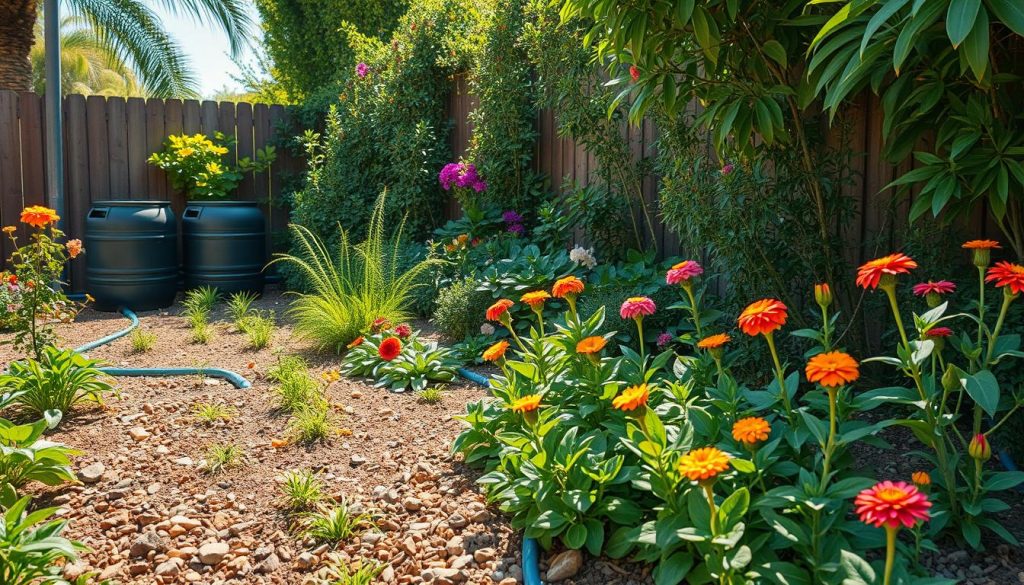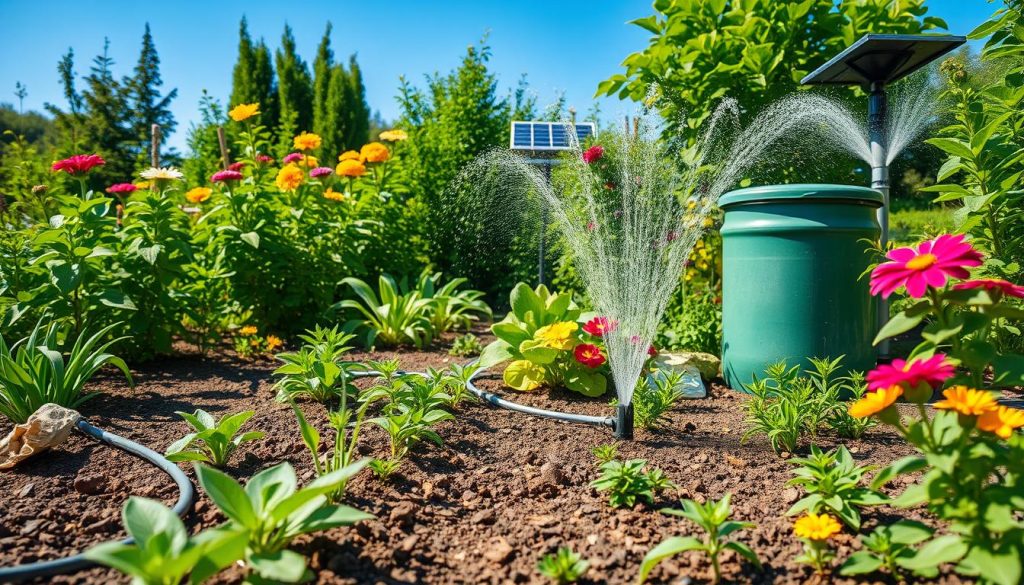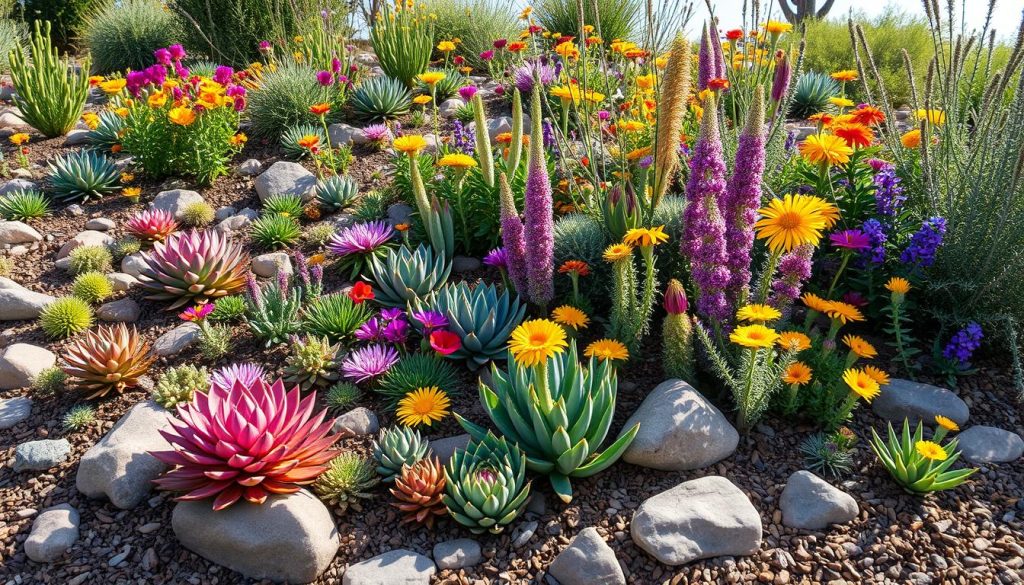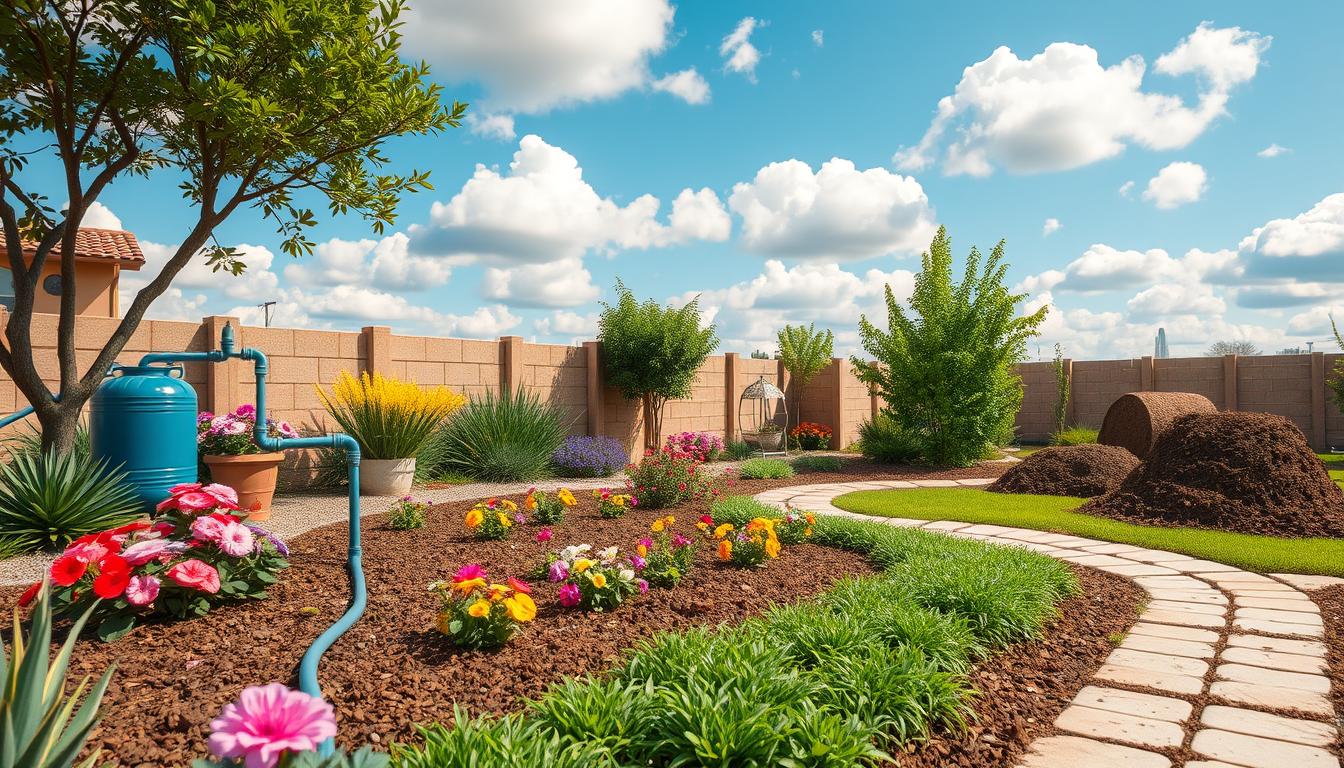As a gardener, I’m eager to cut down on water waste and save money. The United States Environmental Protection Agency (EPA) says gardening and landscaping use a lot of water. This makes me want to learn about water-saving gardening and sustainable practices.
I’m searching for simple ways to waste less water in my garden. Using efficient watering methods and choosing water-saving plants can help a lot. These steps will not only save water but also lower my water bill, which is a big plus.
Learning to waste less water in gardening lets me have a lovely and healthy garden. It also helps the environment. I’m excited to explore sustainable gardening and make a difference in my water use.
Understanding the Importance of Reducing Water Waste
As I explore gardening, I’ve learned how crucial it is to cut down on water waste. Using efficient watering methods helps save water and makes my garden better for the planet. Reducing water waste is good for the environment. It helps fight droughts and water shortages.
Drip irrigation for gardens can cut water use by half. This is compared to old sprinkler systems. It’s a smart way to save water.
I’ve looked into ways to waste less water, like using drought-tolerant plants. These plants and smart irrigation systems help a lot. They make my garden look great and need less care.
Some good things happen when we use less water:
- It saves water for future generations.
- It lowers the chance of droughts and water shortages.
- It makes our gardens better for the planet.
A study by the National Gardening Association shows drip irrigation can save up to 50% of water. This shows how important it is to use water wisely in our gardens. Simple changes can help a lot and make our future greener.
Assessing My Garden’s Water Needs
To make a watering plan for my garden, I need to figure out how much water it needs. I check the soil moisture and know how much water my plants need. This way, I can water my garden just right, saving water and helping plants grow well. Using rainwater for gardening is also a good idea to save water.
First, I check the soil moisture. The USDA says to stick your finger into the soil up to your knuckle. If it’s dry, it’s time to water. I also look for water-saving plants that don’t need much water.
Evaluating Soil Moisture Levels
Soil moisture is key to knowing how much water my garden needs. I can check the soil moisture by:
- Checking the soil color and texture
- Using a soil moisture meter
- Looking at plant signs, like wilting or yellowing leaves
Knowing My Plants’ Water Requirements
Every plant needs different amounts of water. Some, like succulents, need very little, while others, like tomatoes, need more. Knowing this helps me water each plant just right.

Implementing Efficient Irrigation Techniques
To cut down on water waste in my garden, I need to use smart watering methods. This means picking the best irrigation system and following green gardening tips. Doing this will save me money on water bills and help the environment.
The EPA suggests using low-flow irrigation systems and adjusting when to water based on the weather. A smart irrigation controller can help with this. It adjusts watering times based on weather and soil moisture.
Choosing the Right Irrigation System
There are many irrigation systems out there, like drip irrigation, sprinklers, and soaker hoses. Drip irrigation is perfect for my garden. It waters plants right at the roots, cutting down on evaporation and runoff.
How to Embrace Drip Irrigation
To start using drip irrigation, I’ll install a drip system. This means setting up a network of tubes and drippers to water plants directly. I can also use a timer to water at the best times.

Timing My Watering for Maximum Efficiency
Watering at the right time is key to saving water. Watering in the early morning or evening helps plants absorb water better. I can also use a rain sensor to adjust watering when it rains, keeping my garden green.
By using these efficient watering methods, I can make my garden more water-friendly. Drip irrigation, for example, delivers water right to the roots, reducing waste.
Selecting Drought-Resistant Plants
I’ve been looking for ways to cut down on water waste in my garden. Choosing drought-resistant plants is key. It saves water, cuts down on upkeep, and makes my garden look great. This way, I can have a lush garden without harming the environment.
The Lady Bird Johnson Wildflower Center says native plants are great for saving water. They fit right into the local climate and soil. Using xeriscaping tips and sustainable gardening, I can make a beautiful garden that needs less water and care.
Native Plants: Low Maintenance and Water Needs
Native plants are perfect for saving water in gardens. They need less water, care, and upkeep, which is great for gardeners who are busy. Succulents and cacti are good examples. They store water in their leaves and stems, so they don’t need to be watered often.
Perennial versus Annual Plants in My Garden
It’s important to pick the right plants for my garden. Perennial plants come back every year, which means less planting and care. Annual plants need more attention. Mixing both types of plants makes my garden lively and sustainable, needing less water and care.

By choosing drought-resistant, native, and perennial plants, I can make a beautiful, sustainable garden. It will need less water and care. Following these tips and practices, I can enjoy a stunning garden while being kind to the environment.
Enhancing Soil Health to Retain Moisture
To cut down on water waste in my garden, I’ve learned the value of improving soil health. This helps me water less often, which is key for saving water. Adding organic matter to the soil is a top way to do this.
The USDA says adding compost or manure helps soil hold water better. This is because it breaks up clay and makes sandy soils hold more water. So, I use less water and my garden stays healthy even when it’s dry. Using drip irrigation is also a smart move to save water.
- Adding a 2-3 inch layer of organic mulch to retain soil moisture and suppress weeds
- Incorporating compost or manure into the soil to improve its structure and water-holding capacity
- Using cover crops to add organic matter and reduce soil erosion
By using these green gardening methods, my garden stays healthy and needs less water. This not only saves water but also helps the environment.
Tracking and Adjusting My Watering Practices
Keeping an eye on my watering is crucial for saving water in my garden. Using rain barrels to store rainwater cuts down on my use of city water. This saves me money and supports sustainable gardening.
Using Rain Barrels for Sustainable Water Catchment
Installing rain barrels has changed my gardening. When it rains, I collect water for my plants. This method saves water and helps my plants thrive.
Keeping a Watering Schedule: Lessons Learned
Having a regular watering schedule is key. I watch my garden’s needs and adjust my watering. This keeps my plants healthy and helps me use water wisely.

